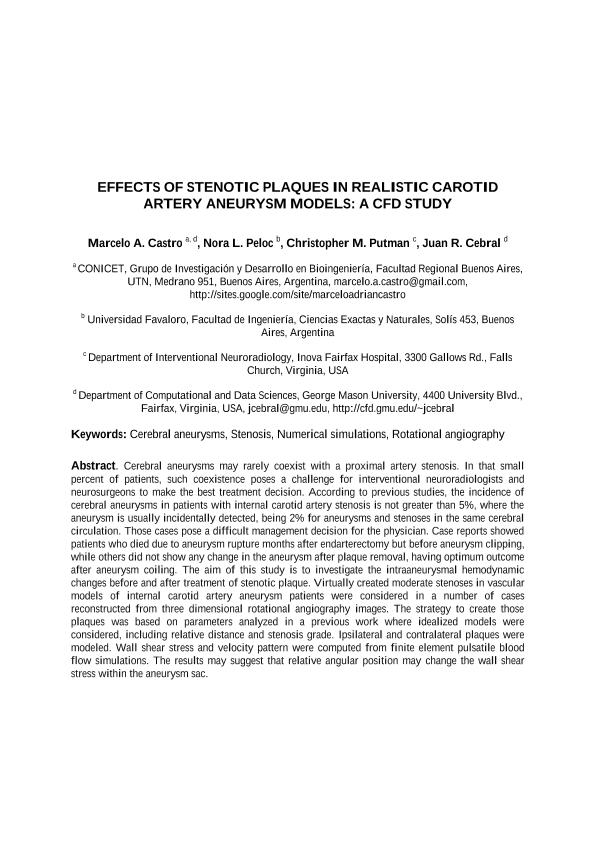Mostrar el registro sencillo del ítem
dc.contributor.author
Castro, Marcelo Adrian

dc.contributor.author
Peloc, Nora Luz
dc.contributor.author
Putman, Christopher M.
dc.contributor.author
Cebral, Juan Raúl
dc.date.available
2018-04-23T17:00:03Z
dc.date.issued
2014-09
dc.identifier.citation
Castro, Marcelo Adrian; Peloc, Nora Luz; Putman, Christopher M.; Cebral, Juan Raúl; Effects of Stenotic Plaques in Realistic Carotid Artery Aneurysm Models: a CFD Study; Asociación Argentina de Mecánica Computacional; Mecánica Computacional; XXXIII; 41; 9-2014; 2677-2687
dc.identifier.issn
2591-3522
dc.identifier.uri
http://hdl.handle.net/11336/43028
dc.description.abstract
Cerebral aneurysms may rarely coexist with a proximal artery stenosis. In that small percent of patients, such coexistence poses a challenge for interventional neuroradiologists and neurosurgeons to make the best treatment decision. According to previous studies, the incidence of cerebral aneurysms in patients with internal carotid artery stenosis is not greater than 5%, where the aneurysm is usually incidentally detected, being 2% for aneurysms and stenoses in the same cerebral circulation. Those cases pose a difficult management decision for the physician. Case reports showed patients who died due to aneurysm rupture months after endarterectomy but before aneurysm clipping, while others did not show any change in the aneurysm after plaque removal, having optimum outcome after aneurysm coiling. The aim of this study is to investigate the intraaneurysmal hemodynamic changes before and after treatment of stenotic plaque. Virtually created moderate stenoses in vascular models of internal carotid artery aneurysm patients were considered in a number of cases reconstructed from three dimensional rotational angiography images. The strategy to create those plaques was based on parameters analyzed in a previous work where idealized models were considered, including relative distance and stenosis grade. Ipsilateral and contralateral plaques were modeled. Wall shear stress and velocity pattern were computed from finite element pulsatile blood flow simulations. The results may suggest that relative angular position may change the wall shear stress within the aneurysm sac.
dc.format
application/pdf
dc.language.iso
eng
dc.publisher
Asociación Argentina de Mecánica Computacional
dc.rights
info:eu-repo/semantics/openAccess
dc.rights.uri
https://creativecommons.org/licenses/by-nc-sa/2.5/ar/
dc.subject
Cerebral Aneurysms
dc.subject
Stenosis
dc.subject
Numerical Simulations
dc.subject
Rotational Angiography
dc.subject.classification
Ingeniería Médica

dc.subject.classification
Ingeniería Médica

dc.subject.classification
INGENIERÍAS Y TECNOLOGÍAS

dc.title
Effects of Stenotic Plaques in Realistic Carotid Artery Aneurysm Models: a CFD Study
dc.type
info:eu-repo/semantics/article
dc.type
info:ar-repo/semantics/artículo
dc.type
info:eu-repo/semantics/publishedVersion
dc.date.updated
2018-02-08T17:51:18Z
dc.journal.volume
XXXIII
dc.journal.number
41
dc.journal.pagination
2677-2687
dc.journal.pais
Argentina

dc.description.fil
Fil: Castro, Marcelo Adrian. Universidad Tecnológica Nacional. Facultad Regional Buenos Aires; Argentina. George Mason University; Estados Unidos. Consejo Nacional de Investigaciones Científicas y Técnicas; Argentina
dc.description.fil
Fil: Peloc, Nora Luz. Universidad Favaloro; Argentina
dc.description.fil
Fil: Putman, Christopher M.. Inova Fairfax Hospital; Estados Unidos
dc.description.fil
Fil: Cebral, Juan Raúl. George Mason University; Estados Unidos
dc.journal.title
Mecánica Computacional

dc.relation.alternativeid
info:eu-repo/semantics/altIdentifier/url/https://cimec.org.ar/ojs/index.php/mc/article/view/4861
Archivos asociados
